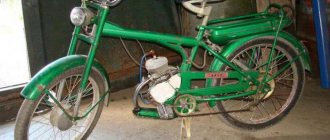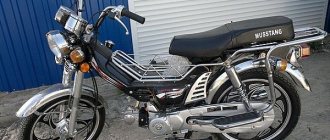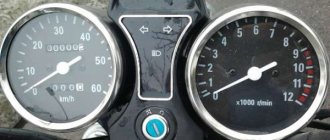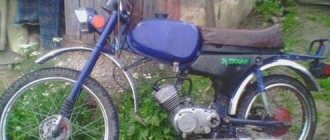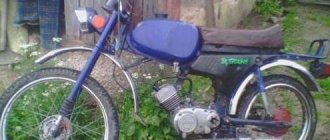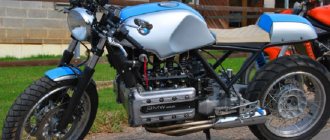Riga (moped)
“Riga”
is a brand of Soviet mopeds and mokicks produced by Riga Moto (translated from Latvian as “Red Star”) in 1958-1998.
Content
Story
"Riga-1"
In 1958, the first moped was produced in Riga. The experience was not entirely successful, and the plant designers went to the Czech Jawa plant for a detailed acquaintance with the production of small-capacity motorcycles. After this, in 1960, 11 copies of “Riga-1” were produced and sent for testing. In 50 days, the copies traveled 10,000 km and the following year 5,000 pieces were produced, in 1962 - 27,000, and in 1965 - more than 90 thousand copies.
"Riga-3"
In 1965, the Riga-1 model was discontinued and was replaced by a new model, Riga-3, equipped with a Siauliai-made Sh-51 engine. However, these engines turned out to be not as reliable as Czech ones and the popularity of mopeds waned. Externally, the Riga-3 moped was not very different from its predecessor, except for the modified shape of the tank, a cushion-type seat and a frame with an extended tail section. "Riga-3" turned out to be almost 30% more powerful than "Riga-1", lighter by 2 kg and accelerated to 50 km/h.
"Riga-4"
From 1970 to 1974, Riga-4 was produced. This model was very similar to the Riga-3 and differed only in a small change in the hull lining and the introduction of new technical solutions to the design: the electrical circuit was changed (a high-voltage transformer was added), the design of the guards for the wheels and chain, the design of the gearbox gears, the trunk, installed new wheels of smaller diameter, and the speedometer was driven by the engine.
"Riga-5"
The light moped “Riga-5” began to be produced in 1966 and was very different from the predecessors of the “Riga” series and from the “Gauja”, in which not a telescopic fork was used to dampen the front wheel, but compressed springs, allowing the fork to bend forward. The design has also been completely changed. The D-5 series engine without gears, started by pedals, made the moped easier to control, but the dynamics of the moped worsened. "Riga-5" initially had a classic bicycle hub on the rear wheel, providing braking in the same way as a bicycle. But already in 1968, a modification appeared with shoe-type brakes on the rear wheel, and for some time both modifications were produced in parallel, after which shoe brakes completely replaced the bicycle-type rear hub. The frame was also strengthened (the corner bracket was lengthened), because the frames of previous models often cracked when driving on bad roads in the area adjacent to the steering column. With proper engine adjustment, Riga-5 ensured starting from a standstill without the help of pedals and, in exactly the same way, “took” very steep uphill climbs. For example, by starting the engine immediately before an incline of approximately 45°, it was possible to smoothly release the clutch and, without pedal assistance, drive up a slope of any length, provided that the quality of the road surface was not too bad. In addition, for the D-5 and D-6 engines, it was important to very carefully adjust the supply of the fuel mixture so that when idling at maximum speed, the engine would neither stall nor “choke” with fuel. The model was produced until 1971 inclusive, after which it was replaced by the Riga-7 moped.
"Riga-7"
The Riga-7 moped began to be produced in 1969. By the end of 1971, it completely replaced the Riga-5 moped. Unlike the Riga-5, it was equipped with a D-6 engine, which made it possible to connect a headlight and rear marker to it; they broke on bad roads at the place where the steering column was attached; The decorative hood of the drive chains has been removed. The design of the Riga-7 moped had a special rack installed to prevent frame breakage in cases of emergency braking. Plant workers H. Akermanis (electrician) and J. Bankovich (mechanic) proposed and tested, both on the stand and in practical driving conditions, a frame design with reinforced rear suspension without a rack. The proposal was accepted, royalties were paid within the time limits stipulated by law, but in 1976 the Riga-7 moped was discontinued, replacing it with the Riga-11.
"Riga-11"
"Riga-11" came out as a hybrid of "Riga-7" and, in fact, the basic model "Riga-9". It was supposed to produce a moped equipped with an engine with an automatic clutch, but after testing, the manufacturer refused to install this engine, changing the design of the moped frame to accommodate the D-6 engine. Wheels of a smaller diameter, but with thicker tires, the original look attracted buyers, but in practice the original look was not in favor of this model. The tank located under the trunk made driving uphill difficult, especially when there was little gas. But the original frame turned out to be fragile.
"Riga-13"
The light moped "Riga-13" replaced the "Riga-11". The moped has been produced since 1983 [1]. It was equipped with a 1.2 hp engine with a maximum speed of 40 km/h. Early models were equipped with a D-6 engine [2], the most common engines are D-8e, D-8 m. Its distinguishing feature is good light and an installed high-voltage transformer, which eliminated frequent problems with the ignition coil. However, the model often failed to ignite: after all, the material of the breaker hammer touching the magnet cam was abraded, which was a typical phenomenon for engines of the “D” series. In “D-6”, in addition, they “modernized” the fastening of the magnetic rotor of the magneto, reducing the knurling depth, as a result of which the magnets often broke off from the central bushing, and the ignition stopped working).
This model was produced until 1998. “Riga-13” is the most popular model of the “Riga” mopeds. One of the disadvantages is the frequent breakdown of the clutch cover.
"Riga-16"
In 1978, the two-speed Riga-16 model was launched into production. It was already a mokick with a kickstarter, a motorcycle-type muffler, a new steering wheel and a tail light. The first Riga-16 models still had the Sh-57 engine; later, one of the most successful Šiauliai engines was installed on the Mokika.
"Riga-17S"
Since 1983, the Riga-17S model was launched into production at Riga. Since the Riga Motor Plant does not have its own engine production and corresponding experimental base, VNIImotoprom took over the design and production of the engine for the racing moped, and Sarkana Zvaigen developed the crew part and fine-tuned the machine as a whole. Engine with a volume of 49.8 cubic centimeters and a power of 16.5 hp. allowed the moped to accelerate to 153 km/h.
"Riga-22"
In 1981, the Riga-22 mokik rolled off the assembly line, which became an improved version of the Riga-16 mokik. This model, which accelerated to 50 km/h, was equipped with the Sh-62 engine. This engine was radically different from previous models, primarily in its powerful electronic ignition and gearbox, which is why it was necessary to change the direction of rotation of the crankshaft. The use of electronic non-contact ignition increased the reliability of engine starting and the reliability of the ignition system as a whole. However, the first models were distinguished by the unreliability of the commutators and gear unit. Therefore, after some time, the engine and switch were modernized, and since 1984 they began to produce mokikis with Sh-62M engines with a power of 1.8 liters. With. In addition, the design of the muffler has changed. Despite the modernization, the gearbox still caused trouble for customers. The cross-country model, unified with the Riga-22 moped, became the Riga-20Yu moped, which was equipped with a more sporty frame, a larger diameter front wheel and foot-operated gear shifting. It was a small-scale moped intended for training and competitions of young athletes. This model was designed by Anton Puris, who was at one time an engineer and a sportsman, having developed this model for fishing trips, hunting trips, and so on.
Consumer Reviews
The owners of the equipment in question recall that “Riga-11” is a moped that has become a childhood dream come true. Its simplicity and low price, along with modernization, have become determining factors in the popularity of this transport in cities and villages throughout the country.
Among the advantages of the car are the following:
- more stable wide wheels;
- upgraded saddle;
- strong and practical moped frame.
Now users are more nostalgic for those moments when they could touch the entire mechanism with their own hands and be proud of it. In modern times, this vehicle serves primarily as a museum exhibit or a memorable rarity.
Riga mini wiring diagram
Welcome to the Riga Mini Stella Fans community page, here you will find information you are interested in on the operation and repair of Soviet mopeds, in particular. Below, the article offers various options for scooter schemes, perhaps some will suit you. On one minivan, the blue one, it was cut and a circuit with turn signals was installed in it. Mini rig wiring diagram. Because the tidy is not yet available, and the mini already wants to be disassembled for cleaning. Photos of the Riga30 minimoped are attached... Back in 1982 at Rizhsky. Please give me a diagram of anyone who has a wiring connection in the Carpathians. 5mm, no cambrics needed, everything fits perfectly. I wanted something quick and easy to lift https://wap.google.com/xhtml/search?q=Porno+ya%C5%9Fl%C4%B1+iri+site:wiga.xyz&num=100&filter=0&gbv=1&sei= 0 spirit, and I decided that it would be a mini Riga. Electrical diagram of mopeds Riga4, Riga12, MP046, Verkhovyna from 3 to 6 models.
Quote from August 16, 2014, 16 35 53 You just need to check the wing at full suspension travel. There is no point in increasing the dimensions of the Mini by lengthening the frame. Electrical equipment The schematic diagram of electrical equipment is shown in. BKS stabilizer switch circuit - MOPEDIST. However, with a weight of 50 kg, it was very problematic to drag one. I sell wiring for Riga mini, I do it myself, good wires, tinned terminals, crimped and soldered, heat-shrink. Stages of conversion of Riga Mini 26 with an engine from Alpha.
I was stunned by the Chinese wiring, judging by common sense, the black wire is ground and the green one is some kind of plus, but no, the black one is a plus after turning on the ignition and the green one is a minus for everything that is in the moped. I have a Riga 16 with a Sh58 engine, I don’t know exactly what kind of car it is, but it looks like a motorcycle. And on Riga mini Lux three switches were installed. Look at the wiring diagram from any moped with a B50 engine. Hello, tell me what to do. Rigamini is still lying in a pile of parts; it requires an incentive to start assembling. But after the collapse of the UNION, the car plant died a natural death because it was no longer needed by the bourgeoisie.
Electrical equipment of the circuit - MOPEDIST.
Mini, on the contrary, where on the BKS it is written Z and D this is to the generator, on the other side where K is to the coil, O2 light, O1 signal. Just yesterday I finished the electrics inside the engine itself and I want to share some information. As the engine was overhauled, I didn’t even try to start it. In addition, for other wiring diagrams Riga 16, Carpathians and some old motorcycles, there is a lower left contact in the switch that is closed with a pin on which the switch goes. I'm interested in the wiring diagram, the length of the harnesses, where you bought the chips for the taillight and the chips for the BKS. Detailed explanation with photos, electrical diagram of fuse and relay blocks for Moto cars. Electrical wiring diagrams for scooters differ depending on their model. The beginning of restoration, or rather refreshing, of the mini Riga Forum. Minimoped Riga26 Moped from Soviet childhood RigaMini minimokic, which has compact dimensions and weight, reaches speeds of up to 50.
Electrical diagram of mopeds Verkhovina7, Karpaty, Karpaty2, Mini, Delta, Stella. Riga13 BSZvet how to UNSEE illuminated by LED. I want to replace the factory carb with some other, more reliable one. Someone post a photo where you can see everything or give a link where you can see it. I could not find patterns with other colors, as well as the original pattern from this particular model, on the Internet. Hello, I came to the conclusion that it’s time to do a project, my hands were itching, I didn’t go to the garage for 4 months. Just stubs, no switches, no frog that turns on the brake light, no pieces of wiring at all.
Please tell me the length of the cable and its free play of the foot brake for the Riga mini, since on my copies they are too big, it’s clear that they were chosen somehow by chance and the appearance is not right. Messages 37 Registration date https://wap.google.com/xhtml/search?q=%D0%A4%D0%BE%D1%82%D0%BE+%D0%B2+%D0%B0%D0%BD%D0 %B0%D0%BB+%D0%BC%D0%B0%D0%BB%D0%BE%D0%BB%D1%96%D1%82%D0%BA%D1%83+site:qune.xyz&num=100&filter =0&gbv=1&sei=0 20121214 Age 22 From Moscow. First, you should assemble the circuit and, WITHOUT CONNECTING THE LIGHTING, make sure it is working and start the engine. For stable, uninterrupted operation of the motor, you need to carefully set the gap on the breaker. I have attached an intelligible diagram for connecting to the remote control. Electrical circuit diagram of the Master Vintik scooter. When starting the moped, the headlight does not light up and the sound signal does not work.
Color diagram of electrical equipment of mopeds Riga4, Riga12.
It is better to assemble the wiring as in Riga22, otherwise there are no difficulties, everything fits. There are two wires going to the woman from the switch. Light on moped Riga 13 Motorcycles, scooters Metal. Let's forgive the boy for the confusion, he will go through the wiring, find a break, and then maybe he will correct us in some way, over time. Help me on how to correctly install the wiring from the engine to the hull, preferably with a photo. Rigamini moped, review, characteristics, tuning. For some reason, in our area, such a moped is a curiosity and actually buying even a soup set was not easy. But the motors and wiring diagram are the same as in Riga. Yesterday I wove new wiring for the Mini Riga, but I still didn’t seal it in PVC and heat shrink. Mini rig wiring diagram. everything is covered in cambric, white or black as desired. We need electrical circuits for rig 16 for the high-beam front light, parking brake rear light and front parking light, a car LED will do.
Closest competitors
Among the mopeds of that time, Riga-11 did not have many competitors in its class. Units from the same manufacturer under the indexes 7, 12 and 16 were popular. They differed from the eleventh modification in the location of the gas tank, frame structure, wheel width and some modifications to the engine. Otherwise, the mopeds were almost identical.
Of the other Soviet manufacturers producing competitive equipment, we can mention Verkhovyna. It is worth emphasizing that many spare parts for mopeds were interchangeable, easy to operate, maintain and repair.
D series engines: 6, 5, 4, 8: characteristics, malfunctions and tuning
The D6 two-stroke single-cylinder engine has a carburetor power system and is intended for installation on various modifications of mopeds. Today, due to its versatility of use, efficiency and simplicity, this engine is widely used with various light agricultural equipment and on homemade mopeds.
Specifications
| OPTIONS | MEANING |
| Cylinder block material | aluminum |
| Working volume, cubic meters cm | 45.4 |
| Power at 4500 rpm, l. With. | 1 |
| Number of cylinders | 1 |
| Cylinder location | forward tilt 14°30′ from vertical clockwise when viewed from the magneto side |
| Idle speed, rpm | 2600 |
| Piston stroke, mm | 40 |
| Cylinder diameter, mm | 38 |
| Carburetor | K34B |
| Spark plug | A10NT, A10N, ANN GOST 2043-74 |
| Compression ratio | 6 |
| Fuel | Gasoline A 72 mixed with oil (15:1 during break-in and 25:1 after) |
| Fuel consumption (at speed 25 km/h), l per 100 km | 1.8 |
| Spark plug | A 10N, A11 N GOST 2043-74 |
| Air purifier | reticulate |
| Clutch | friction, double-disc, semi-dry |
| Weight, kg | 6.5 |
The engine was installed on Riga mopeds.
Description
In the middle of the last century, there was active development of compact single-cylinder engines, which were intended for installation on motorbikes, mopeds and compact agricultural equipment. As a result, the D4, D5, D6 and D8 engines were developed and gained popularity. Such power units were easy to use, reliable and undemanding to maintain.
Due to the simplicity of their design, the engines are easily attached to the frame of a motorbike using support clamps. The transmission of rotation from the engine to the rear wheels of mopeds is carried out through clutches and a corresponding roller chain. D6 does not imply the use of a gearbox, which greatly simplifies the use of the equipment. The operation of the power unit is controlled through the throttle handle, which is mechanically connected to the carburetor.
D-series engines, despite their compact dimensions and small displacements, provide light mopeds with excellent dynamics. On a flat road, a light motorbike can accelerate to 40 kilometers per hour. At the same time, due to the traction reserve, the equipment could also be used on country roads. Let us note that today, more than half a century after the start of production of these power units, they are still in demand among domestic motorists and are successfully used on light equipment.
Modifications of D series engines
- Initially, production of the D 4 engine began, which had a working volume of 45 cubic centimeters, weighed 9 kilograms and developed about 1 horsepower at 4000 rpm.
- In 1961, the D 5 engine appeared, which featured an increased compression ratio, which increased power to 1.2 horsepower. At the same time, this power unit was distinguished by low fuel consumption and consumed about one and a half liters of gasoline per 100 kilometers. Among the disadvantages of this power unit, we note its increased noise and the need to use an additional cylinder with a removable head and developed ribs. Such a cylinder is used due to the high thermal load of the power unit.
- After a thorough modernization of the D 5 power unit, a new motor was released, which was called D 6. This engine had an enlarged winding and a rotor with a diameter of 66 millimeters. We also note the use of a magneto, which improved engine starting and adjusted the performance of the power unit for the better. The power of this engine was sufficient for use on light mopeds.
- The D 8 engine modification has improved windings that produce 12 Volts, as well as a rotor of increased volume.
Similar modifications of single-cylinder two-stroke engines have been manufactured for 50 years and have been in demand among car owners. Only after the collapse of the Soviet Union, the factories producing these engines were located abroad in Riga and Lvov, and soon they went bankrupt, after which the production of D series engines was stopped. Subsequently, attempts were made at motor plants in St. Petersburg and Penza to resume production of these power units, but such measures were unsuccessful. Currently, D series motors are not manufactured.
Modifications of the D 6 motor
If we talk about the D 6 engine family, then it must be said that buyers were offered two modifications of this power unit, which were indexed D6 and D6U. Structurally, both of these motors are the same, with the exception of the drive chains used: for D 6 PR-12.7-900 GOST 10947-64; for D6U PR-12.7-1800-1 GOST 10947-64.
This power unit was air-cooled, which made it possible to significantly simplify the design of the motor. At the same time, thanks to the appropriate location of the combustion chamber, it was possible to completely solve the problem with thermal loading, eliminating the need to use an additional ribbed cylinder for effective cooling of the power unit.
The carburetors used and the entire power system were reliable, and the efficiency of the engine made it possible to reduce the costs of its operation. No carburetor maintenance was required. You just need to remember that, like most of these motorcycle engines, this engine runs on a mixture of gasoline and oil.
To prepare a high-quality fuel mixture, it was necessary to use a mixture of A-72 or A-76 gasoline with oil in a ratio of 25:1 (during break-in 15:1). But it is prohibited to operate this power unit on gasoline alone, as this quickly leads to serious engine damage.
Maintenance
As mentioned above, service work does not pose any difficulty. Every thousand kilometers it is necessary to clean the spark plugs from carbon deposits, check the gap between the spark plug electrodes and determine the correct tightening of the nuts securing the cylinder head and the cylinder itself. Also, with this mileage, the idle speed is adjusted, the magneto is cleaned and the air cleaner is washed in gasoline.
Once every 3,000 kilometers, the engine ignition is checked, the clutch bearings are lubricated, and the fuel tank is flushed with clean gasoline. It is also recommended to clean the cylinder head and pistons every 3,000 kilometers. It is not recommended to perform any more maintenance work when operating the unit in the warm season.
Malfunctions
| FAULT | CAUSE |
| When the throttle is open, the power unit increases speed, but no thrust appears. | The cause may be slipping of the clutch, which requires appropriate adjustment or replacement. |
| The spark plug does not produce a spark and the engine does not start. | It is necessary to make sure that the spark plug is working and check the magneto. |
| The spark plugs are wet and the engine is running rough. | While parked, the fuel supply valve was not closed or the carburetor needle valve was damaged. |
| The engine will not start. | The problem could be a lack of fuel or a carburetor failure. In this case, the fuel system is inspected, the problem is determined and it is repaired. |
